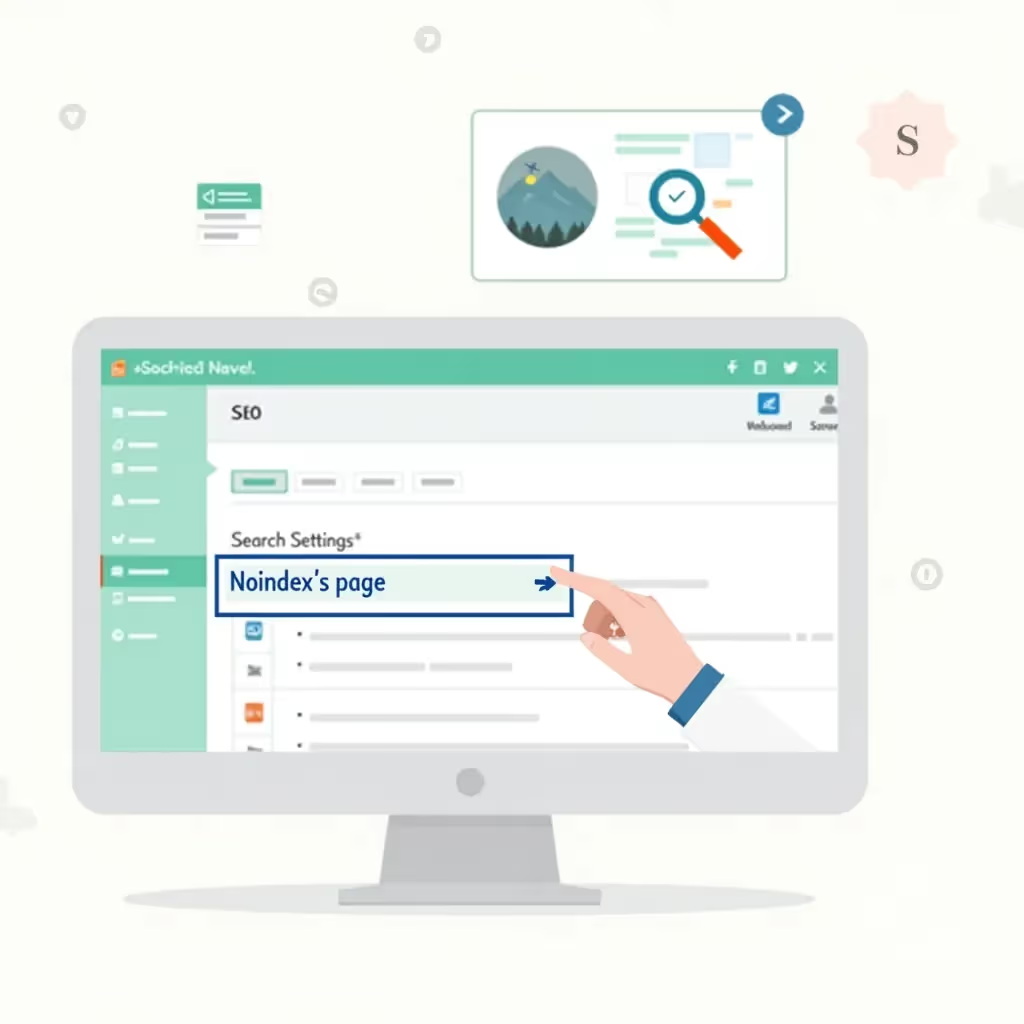Key Takeaways
- Google’s perspective on AI-generated content is constantly changing.
- In April 2022, John Mueller, a Google Search advocate, explicitly said not to use generative-AI content and called it spam.
- From November 2022 to December 2022, Google’s surrogates spoke more positively about using AI for parts of the content creation process (for instance, titles and outlines).
- In February 2023, Google updated its official guidance to clarify that it allows AI-generated content, but with a number of important considerations.
- You can use generative AI during the content creation process, but you shouldn’t create content just for the purpose of manipulating search results. Don’t copy and paste entire articles from tools like ChatGPT.
- You should work to add first-party expertise and experience to the content you’re creating. You can start writing with AI, but you should push yourself to publish original content based on your unique expertise and authority. Follow E-E-A-T guidelines (more below)!
- If you’re hiring freelance writers or content agencies, you should check to see whether the content you’re paying for is, in fact, original content.
In my content marketing circles, everyone is talking about AI-generated content. And in 2023, many teams are using AI-generated content as a core part of their content marketing strategy.
Toolsets like ChatGPT have made creating AI-generated content incredibly fast, easy, and, importantly, cheap. But the question is, Should you be using AI-generated content as part of your search engine optimization strategy?
As someone who has spent upwards of $1 million on content creation over the past decade, the idea of replacing an expensive and often slow-moving team of writers with AI is quite compelling. Organic search is already a very high-margin channel due in large part to the long-lasting dividends that quality content brings and just think about that margin expansion with AI.
That being said, I’ve been in this industry long enough to know that every two to three years, a new strategy comes to market, it is exploited, and Google takes action and penalizes websites. And creating content programmatically isn’t a completely new concept. You probably remember the days of spun content. I’ve personally seen websites heavily reliant on programmatic strategies go from hundreds of thousands of readers per month to zero overnight.
In April 2022, I remember very clearly that Google Search advocate John Mueller took an incredibly hard stance on AI-generated content, calling it spam and saying it would be subject to penalties if it was found by the Webspam Team.
But with the rapid rise in popularity of tools like ChatGPT, Google has changed its tune, sort of. In this article, I’ll recap Google’s most recent guidelines on AI-generated content and help to provide context on how you can follow these guidelines.
April 2022 | Google’s John Mueller Comments
In April 2022, John Mueller, a Google Search advocate, made waves across Twitter and in content marketing communities by taking a hard stance against AI-generated content. On April 1, 2022, during one of his Google SEO Office Hours, John was asked about Google’s perspective on using AI to create content:
English Google SEO office-hours from April 1, 2022
In the video, Rohan Chaubey asked John to describe Google’s official position on using AI tools to create content and then asked him to provide suggestions for content marketing teams.
John very quickly responded by saying that content created with generative-AI tools would fall into the category of automatically generated content, which Google has provided guidance on in its Webmaster Guidelines. John compared AI-generated content to spun content, although it is of higher quality, and stated clearly that it would still be considered against the Webmaster Guidelines.
Rohan then asked John whether Google is able to discern between human and AI-generated content. John said that he couldn’t make that claim but that if the Webspam team does see AI-generated content, they could take action against it — and that this is something that the Webspam team is currently thinking about.
John went on to say that these tools may be helpful for being more efficient when writing, and he compared them to grammar-checking tools such as Grammarly.
He then clarified to say again that if the Webspam team were to run across AI-generated content, they would see that content as spam. And in general (Nate’s opinion), that may cause a negative impact on a website as a whole.
This conversation generated quite a bit of buzz, as you would expect. And at the end of April, Google updated its Webmaster Guidelines from saying that we should avoid “automatically generated content” to saying that we should avoid “automatically generated content intended to manipulate search rankings.”
Google has since gone on to update its Webmaster Guidelines, now called Search Essentials, to classify this type of content as “spammy automatically-generated content,” and they’ve provided a number of examples:

Source: Google Search Essentials
Of the six examples above, the third hit the hardest for me. Google is clearly saying that text generated through automated processes without regard for quality or user experience would be considered spam. Cough, cough — that would be copying, pasting, and then publishing 40 keyword-targeted articles from ChatGPT.
November 2022 to December 2022 | Google’s Danny Sullivan Comments
After John’s comments in April, the search community continued to debate the use cases for AI-generated content.
In August 2022, Google published an article called “More Content by People, for People in Search,” and in it, Google mentioned that it was rolling out a series of updates to Google Search to make it easier for people to find helpful content made by, and for, people.
And toward the end of 2022, John Mueller and Danny Sullivan, Google’s Public Liaison for Search, went on to provide guidance on their social media channels. In November 2022, Danny responded to a Twitter thread discussing the use of AI-generated content:
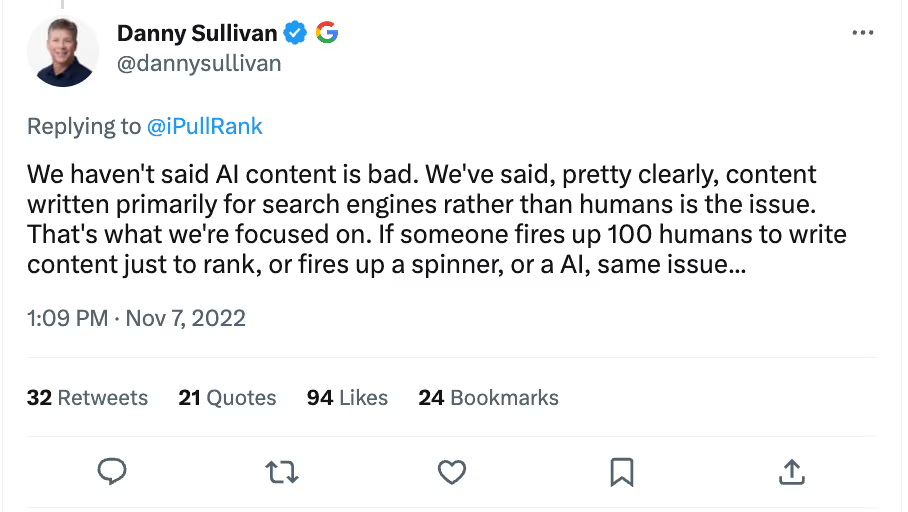
Source: Twitter
Danny goes on to say that AI content isn’t bad and that the real issue is the idea of creating content at scale specifically to manipulate search engines. That is, you shouldn’t be using massive amounts of low-quality content as a way to manipulate search engines — it doesn’t matter whether that content was written by humans or by AI.
In December 2022, John Mueller chimed in on a conversation on Mastodon about using AI to write titles and meta descriptions:

Source: Mastodon
John mentions that AI might be a great toolset for coming up with inspiration for titles and meta descriptions. And based on the guidelines in Google Search Essentials, at the time of this writing, using AI for generating titles and meta descriptions wouldn’t be against the guidelines as long as they aren’t being used without regard to user experience.
By the end of 2022 and into 2023, the popularity of tools like ChatGPT was soaring. And the conversation broadened from SEO communities to marketing communities as a whole.
February 2023 | Google Publishes In-Depth Guidelines
In February 2023, Google released updated guidance on using generative AI in the content production process. On February 8, Google published an article titled “Google Search’s Guidance About AI-Generated Content.”
In the article, Google reiterates its belief in the future of AI and in AI’s power to deliver helpful information, as well as Google’s commitment to showing its users the highest-quality content possible.
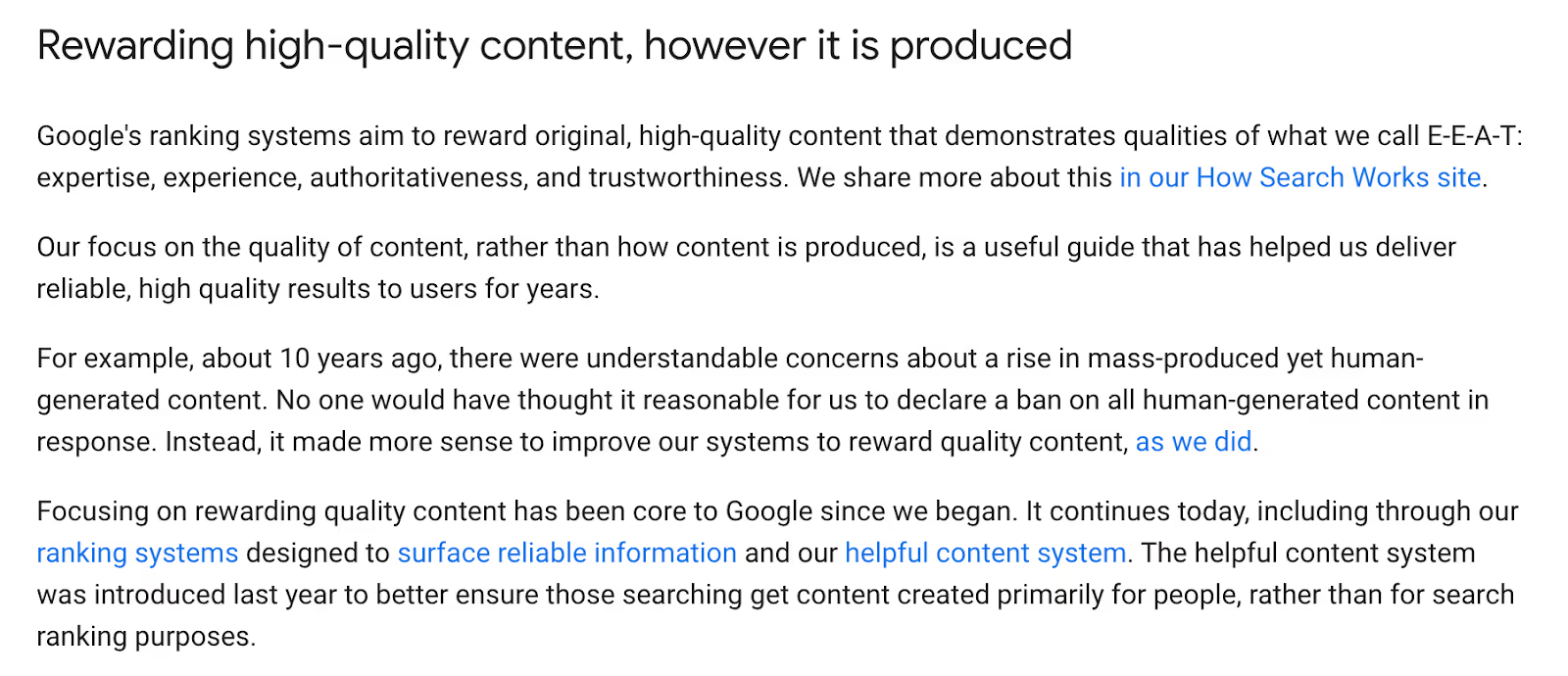
Source: Google Search Central Blog
In the post, Google makes it clear that it wants to reward good content, however that content is produced.
Then Google goes on to say, in short, that you should focus on the quality of the content you’re creating and use Google’s E-E-A-T guidelines to show Google (and searchers) that your byline and/or website has expertise, experience, authoritativeness, and trustworthiness.
Nate’s Take: You can use AI to create content, but you should edit the content, add to it, make it original, and demonstrate your expertise and experience. Make content that is actually helpful for searchers and not just regurgitated garbage, whether you’re creating content with humans or with the assistance of AI.
Google then goes on to clarify how AI tools may be helpful for content creators but that its spam-fighting efforts will continue.
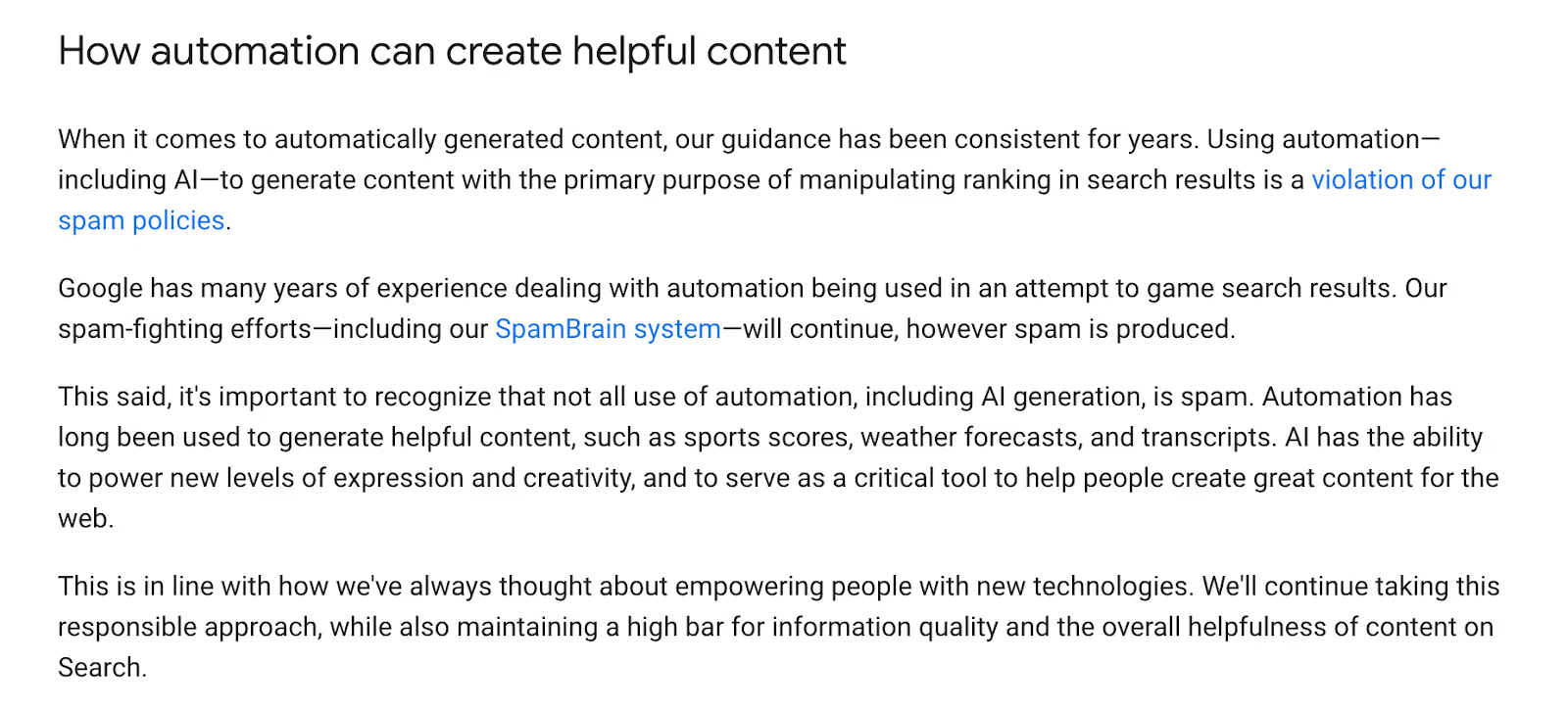
Source: Google Search Central Blog
Google again highlights its spam policies, which we discussed earlier, and which explicitly state that the primary purpose of using an AI tool shouldn’t be to manipulate search rankings.
Nate’s Take: Creating content with AI isn’t evil, and there are good use cases. That being said, Google’s SpamBrain system is actively looking for low-quality content that was created for the primary purpose of manipulating search rankings. If you can use AI to improve the quality of the content you’re creating, that would be a good thing.
In the post, Google goes on to provide even more guidance for content creators:
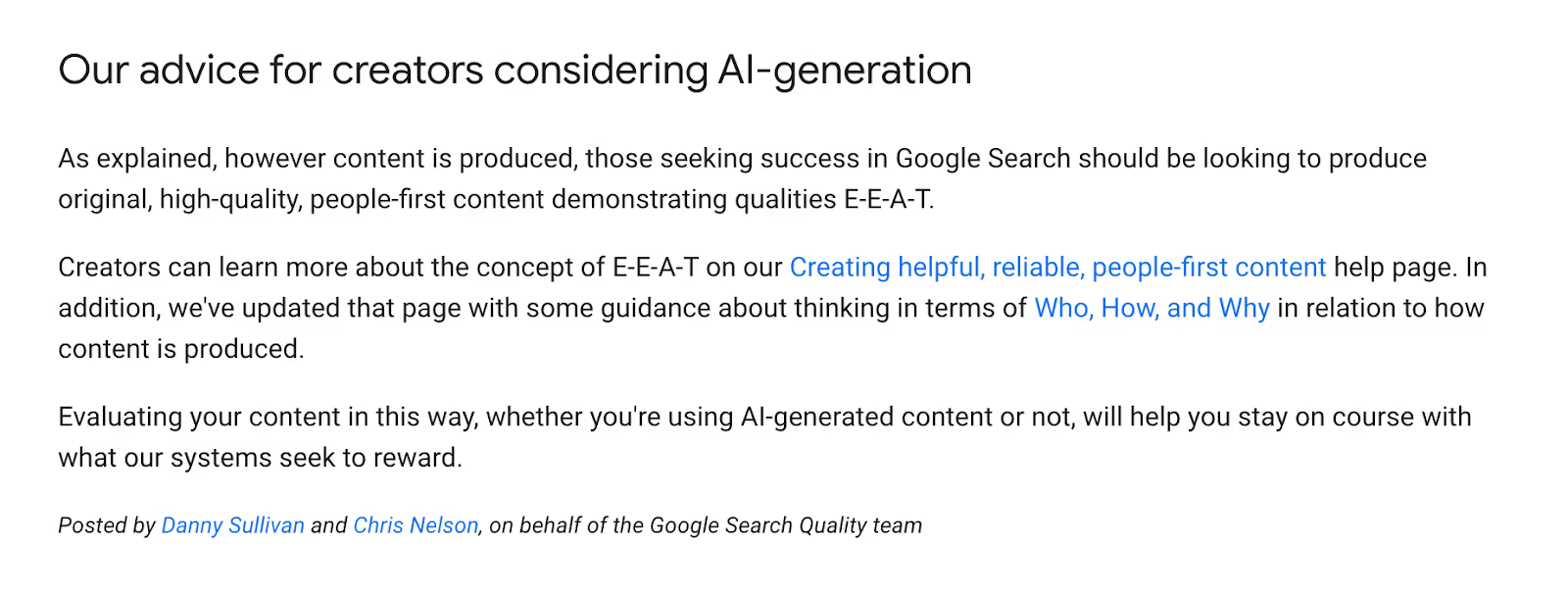
Source: Google Search Central Blog
Google reiterates E-E-A-T yet again and reminds content creators to think about the Who, How, and Why when they’re creating content.
Nate’s Take: Produce high-quality content, with the help of AI or not, that is intended to help the searcher answer their questions because nearly all search queries are really questions. As I always say, the most important part of any content marketing strategy is to actually create fantastic and engaging content. In 2023, I’m skeptical that AI alone can create unique fantastic content, so if you are using AI, you’ll want to make sure to add to and polish that content with your personal experience and the expertise that only you, the expert, would have.
Google goes on to address nine frequently asked questions about using AI to create content. I suggest reading the entire list of FAQs here, but I’ve picked four of my favorites.

Source: Google Search Central Blog
Nate’s Take: You can use AI, but don’t spam your site to death by copying and pasting articles straight from tools like ChatGPT.

Source: Google Search Central Blog
Nate’s Take: Google is working to improve its algorithms, like SpamBrain, so that low-quality content created entirely by AI doesn’t take over search engines.

Source: Google Search Central Blog
Nate’s Take: You might be able to rank content created with AI, but if it isn’t actually fantastic content and if you aren’t following the E-E-A-T guidelines, it likely won’t rank very well.

Source: Google Search Central Blog
Nate’s Take: Don’t publish your content under generic bylines. As always, Google wants to see an actual author for your posts and to see that the author is a true expert and an authority on the topic they’re writing about.
Final Thoughts
Google’s stance on AI-generated content has changed quite a bit in the past year.
Today, Google has made it clear that you can use AI tools to help you create fantastic content. But you shouldn’t copy and paste entire articles from tools like ChatGPT onto your website. You want to use AI as a supplement to writing a great article, and you should work to add your own perspective, expertise, and experience to each piece of content you create. It’s your personal experience that turns a mediocre piece of content into a fantastic piece. And along the way, you should keep Google’s E-E-A-T guidelines in mind.
At Positional, we are building a number of tools for content marketing teams. As part of our toolset, we launched AutoDetect. AutoDetect is a toolset for detecting AI-generated content. If you’re hiring freelancers or agencies to create content for you, you can use AutoDetect to ensure that the content you’re creating and publishing is original and that it hasn’t been plagiarized either from AI or another source on the internet.
If you’re interested in learning more about our private beta, you can sign up for our waitlist on the homepage of our site. You can also email me anytime at nate@positional.com.





